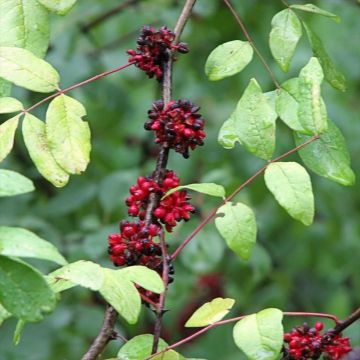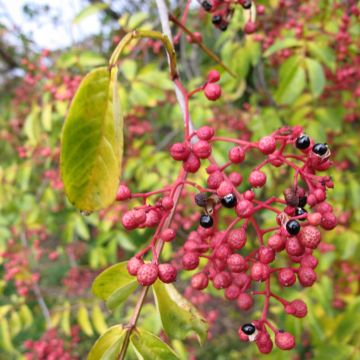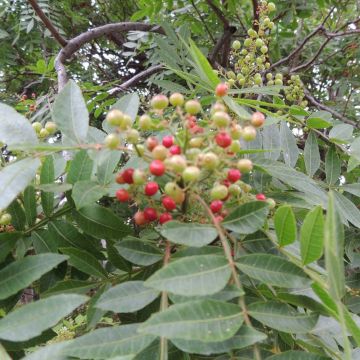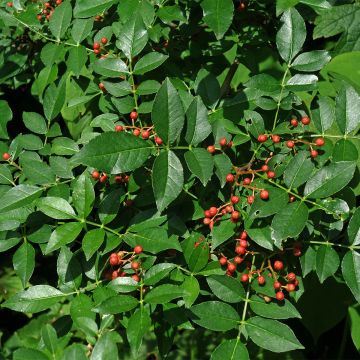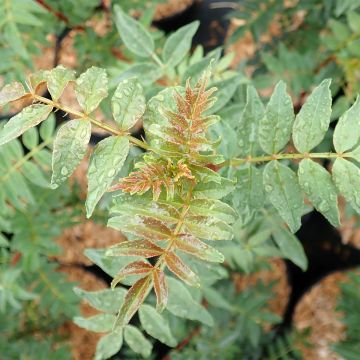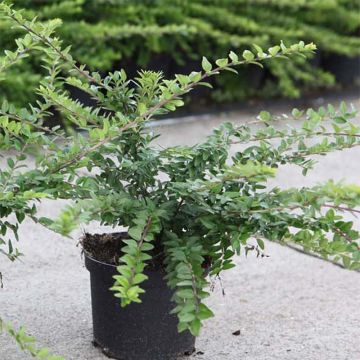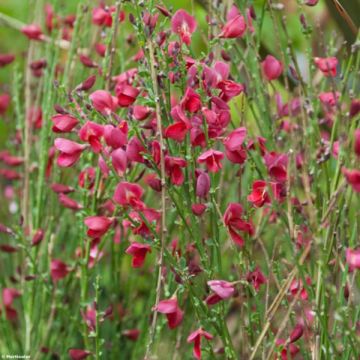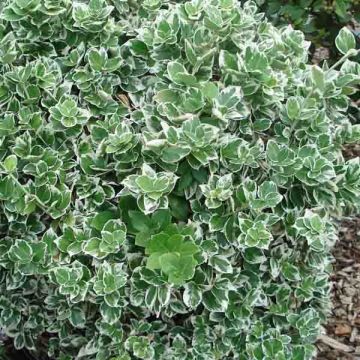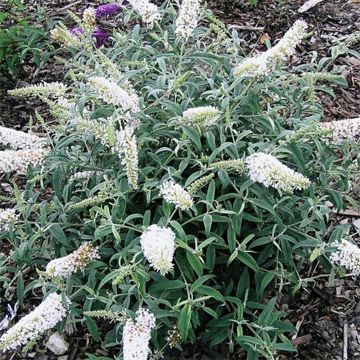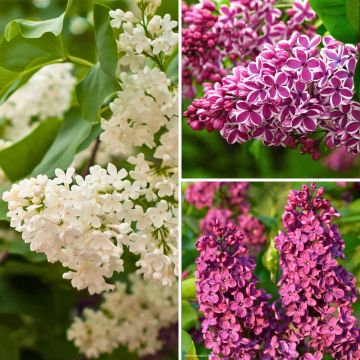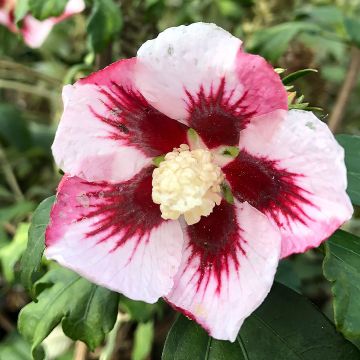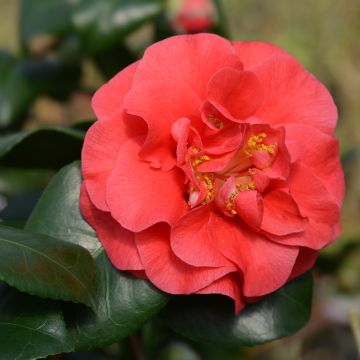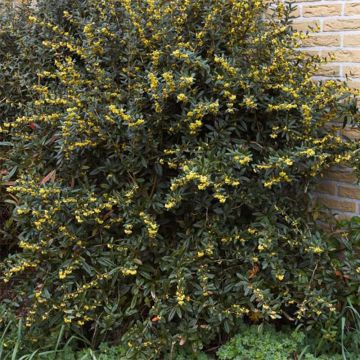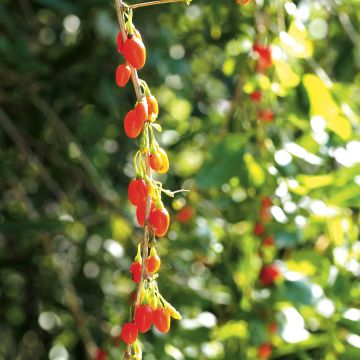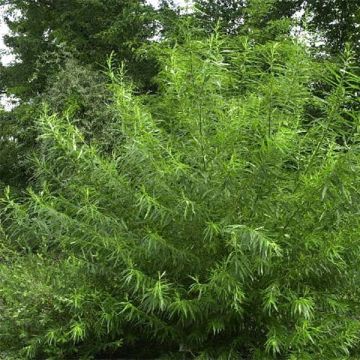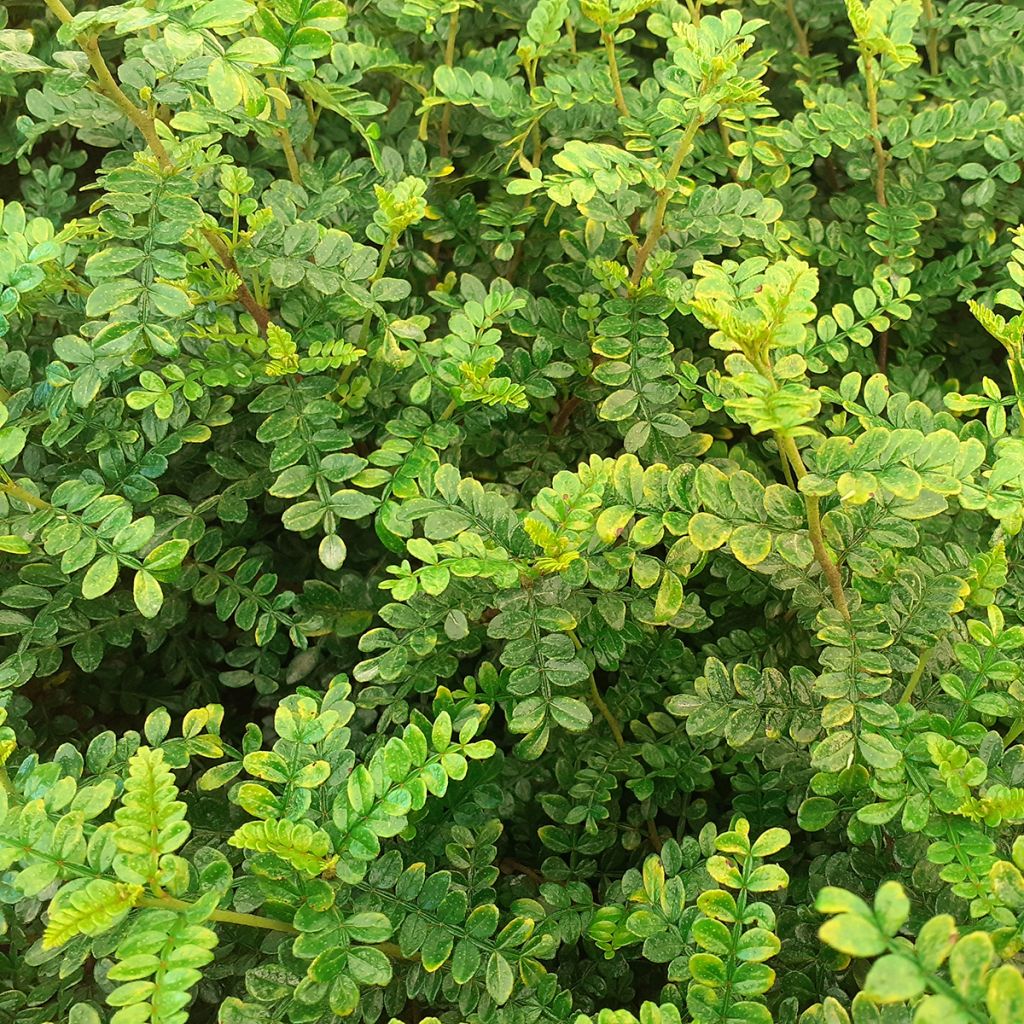

Zanthoxylum beecheyanum
Zanthoxylum beecheyanum
Zanthoxylum beecheyanum
Chinese Pepper, Szechuan Pepper, Beechey's Pricklyash
This item cannot be shipped to the selected country
Delivery charge from €5.90
More information
Schedule delivery date,
and select date in basket
This plant carries a 24 months recovery warranty
More information
We guarantee the quality of our plants for a full growing cycle, and will replace at our expense any plant that fails to recover under normal climatic and planting conditions.
From €5.90 for pickup delivery and €6.90 for home delivery
Express home delivery from €8.90.
Does this plant fit my garden?
Set up your Plantfit profile →
Description
Zanthoxylum beecheyanum, nicknamed Chinese Dwarf Pepper has small shiny leaves, arranged in a decorative palm, emitting an enchanting fragrance. It is highly sought after for its flavour and aroma, particularly appreciated in Asian cooking. With its bushy habit, this shrub captivates the eye with its light, fresh and shiny green foliage, subtly yellowish in hue. In October, the berry husks are harvested to be transformed into a powder with a fruity and lemony fragrance that will enhance your dishes. Under the sun, whether on a balcony or a terrace, it is best to place it at a height where you can fully enjoy the delicious citrus scents emanating from its foliage with the slightest touch. It is a drought-resistant, moderately hardy shrub, which needs protection from the cold. Appreciated by bonsai enthusiasts, this small shrub, with balanced proportions, is characterised by its very small leaves and distinctive bark, giving it a mature appearance from a young age.
Originally from temperate or subtropical Asian areas, Zanthoxylum beecheyanum (syn. Fagara alata var beecheyana) is widely spread from Japan to Vietnam. It belongs to the same family as citrus trees, the Rutaceae family, with which it shares a highly aromatic foliage. The few species that make up the Zanthoxylum genus are sometimes difficult to differentiate, often determined by the number of leaflets that make up the leaves or by morphological characteristics at the flower, thorn, or main vein level of the leaves... This small shrub is evergreen in subtropical regions but may lose part of its foliage in winter in our climates. It thrives in well-draining and sufficiently deep soil. Late frosts can, however, harm flowering and burn its young shoots. Only dense shade discourages this intrepid Chinese pepper.
With a strongly branched and woody base, this shrub has reddish upright stems that give it a compact and rounded silhouette. Its fairly rapid growth allows it to easily reach a height of 1.50 m with a spread of 1.20 m. The small, pinnate leaves are vibrant green and glossy, and emit a citrus fragrance when touched. Flowering occurs in May-June, earlier or later depending on the climate, on one-year-old branches, in the form of small cream-yellow and red flowers. After pollination, round, 2 to 4 mm in diameter, round and warty fruits form. In autumn, their fleshy envelope turns pink-red when ripe, opening to reveal black and shiny seeds. The berries, appreciated for their sweet and aromatic flavour, are used in oriental cooking under the common name of "Sichuan pepper". Self-fertile, it can produce on its own, but the berry yield will be higher if at least 2 plants are planted in the garden.
In cooking, the leaves of this pepper are appreciated for their powerful lemony flavour, adding a surprising touch to many dishes. In addition to its use as a condiment, these leaves are traditionally known for their therapeutic properties, particularly as an anesthetic for dental pain.
Cultivating the Chinese Dwarf Pepper, whether in the ground or in a pot, is surprisingly simple. To enjoy its delicate fragrance, it can be planted in a rock garden, at the edge of a flower bed, or in a container on a terrace. It thrives in fertile, non-calcareous soil to avoid chlorosis, and well-drained soil, avoiding any water stagnation. Its growth, although quite slow, remains constant. This plant prefers sunny or partially shaded areas and can tolerate moderate periods of drought during the summer and some frost during the winter. Its cold resistance is about -8/-10°C, as long as these conditions do not last long and are not combined with high humidity in the environment. Thanks to its constant, dense, and compact growth, Zanthoxylum beecheyanum easily adapts to pruning. It is appreciated for creating trimmed shapes or low, green, and fragrant hedges. Thanks to its Mediterranean behaviour, it offers many possibilities for associations with other shrubs such as Pittosporum tobira var. nana Mont Ventoux Snow, Myrtles, Rockroses, Olearia, Grevillea, or even Callistemons. In very mild regions this plant can be successfully integrated into a well-protected orchard, alongside Feijoa fruit trees (Acca), Mandarin trees, and Carissa macrocarpa (Natal Plum).
Report an error about the product description
Plant habit
Flowering
Foliage
Botanical data
Zanthoxylum
beecheyanum
Rutaceae
Chinese Pepper, Szechuan Pepper, Beechey's Pricklyash
Fagara alata var beecheyana
China
Other Zanthoxylum - Prickly Ash
Planting and care
Zanthoxylum beechyanum or Dwarf Chinese Pepper is best planted in spring or early autumn. Choose a location sheltered from cold and dry winds that could destroy its flowering and burn its young shoots. A sunny or semi-shaded exposure is suitable, only dense shade prevents it from flowering and fruiting. It appreciates deep, loose, fertile, and well-drained soils. It does not tolerate the presence of limestone in the soil well (risk of chlorosis) and adapts to slightly acidic to neutral soils if they are not too poor. Its growth is normal if the soil remains moist in summer. Once established, after 3 years of cultivation, it is capable of surviving without watering in summer. Resistant to -8°C, it is more sensitive during its young years, especially in heavy and wet soil: lighten your garden soil if necessary with a supply of river sand, gravel, or volcanic ash. In very cold regions, protect young plants with a winter fleece and mulch the base.
Pay special attention to watering during the first two years to promote optimal root recovery. Mulch the base in summer to maintain soil moisture. For subjects in pots or containers, make sure to water more frequently.
Planting period
Intended location
Care
This item has not been reviewed yet - be the first to leave a review about it.
Hedge shrubs
Haven't found what you were looking for?
Hardiness is the lowest winter temperature a plant can endure without suffering serious damage or even dying. However, hardiness is affected by location (a sheltered area, such as a patio), protection (winter cover) and soil type (hardiness is improved by well-drained soil).

Photo Sharing Terms & Conditions
In order to encourage gardeners to interact and share their experiences, Promesse de fleurs offers various media enabling content to be uploaded onto its Site - in particular via the ‘Photo sharing’ module.
The User agrees to refrain from:
- Posting any content that is illegal, prejudicial, insulting, racist, inciteful to hatred, revisionist, contrary to public decency, that infringes on privacy or on the privacy rights of third parties, in particular the publicity rights of persons and goods, intellectual property rights, or the right to privacy.
- Submitting content on behalf of a third party;
- Impersonate the identity of a third party and/or publish any personal information about a third party;
In general, the User undertakes to refrain from any unethical behaviour.
All Content (in particular text, comments, files, images, photos, videos, creative works, etc.), which may be subject to property or intellectual property rights, image or other private rights, shall remain the property of the User, subject to the limited rights granted by the terms of the licence granted by Promesse de fleurs as stated below. Users are at liberty to publish or not to publish such Content on the Site, notably via the ‘Photo Sharing’ facility, and accept that this Content shall be made public and freely accessible, notably on the Internet.
Users further acknowledge, undertake to have ,and guarantee that they hold all necessary rights and permissions to publish such material on the Site, in particular with regard to the legislation in force pertaining to any privacy, property, intellectual property, image, or contractual rights, or rights of any other nature. By publishing such Content on the Site, Users acknowledge accepting full liability as publishers of the Content within the meaning of the law, and grant Promesse de fleurs, free of charge, an inclusive, worldwide licence for the said Content for the entire duration of its publication, including all reproduction, representation, up/downloading, displaying, performing, transmission, and storage rights.
Users also grant permission for their name to be linked to the Content and accept that this link may not always be made available.
By engaging in posting material, Users consent to their Content becoming automatically accessible on the Internet, in particular on other sites and/or blogs and/or web pages of the Promesse de fleurs site, including in particular social pages and the Promesse de fleurs catalogue.
Users may secure the removal of entrusted content free of charge by issuing a simple request via our contact form.
The flowering period indicated on our website applies to countries and regions located in USDA zone 8 (France, the United Kingdom, Ireland, the Netherlands, etc.)
It will vary according to where you live:
- In zones 9 to 10 (Italy, Spain, Greece, etc.), flowering will occur about 2 to 4 weeks earlier.
- In zones 6 to 7 (Germany, Poland, Slovenia, and lower mountainous regions), flowering will be delayed by 2 to 3 weeks.
- In zone 5 (Central Europe, Scandinavia), blooming will be delayed by 3 to 5 weeks.
In temperate climates, pruning of spring-flowering shrubs (forsythia, spireas, etc.) should be done just after flowering.
Pruning of summer-flowering shrubs (Indian Lilac, Perovskia, etc.) can be done in winter or spring.
In cold regions as well as with frost-sensitive plants, avoid pruning too early when severe frosts may still occur.
The planting period indicated on our website applies to countries and regions located in USDA zone 8 (France, United Kingdom, Ireland, Netherlands).
It will vary according to where you live:
- In Mediterranean zones (Marseille, Madrid, Milan, etc.), autumn and winter are the best planting periods.
- In continental zones (Strasbourg, Munich, Vienna, etc.), delay planting by 2 to 3 weeks in spring and bring it forward by 2 to 4 weeks in autumn.
- In mountainous regions (the Alps, Pyrenees, Carpathians, etc.), it is best to plant in late spring (May-June) or late summer (August-September).
The harvesting period indicated on our website applies to countries and regions in USDA zone 8 (France, England, Ireland, the Netherlands).
In colder areas (Scandinavia, Poland, Austria...) fruit and vegetable harvests are likely to be delayed by 3-4 weeks.
In warmer areas (Italy, Spain, Greece, etc.), harvesting will probably take place earlier, depending on weather conditions.
The sowing periods indicated on our website apply to countries and regions within USDA Zone 8 (France, UK, Ireland, Netherlands).
In colder areas (Scandinavia, Poland, Austria...), delay any outdoor sowing by 3-4 weeks, or sow under glass.
In warmer climes (Italy, Spain, Greece, etc.), bring outdoor sowing forward by a few weeks.

































